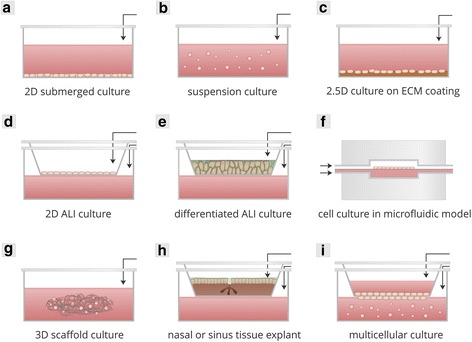Fig. 2.

Schematic overview of the categories of cell culture used to model airway tissue and host-microbe interaction in the airways. Black arrows indicate where addition of bacteria, bacterial cell wall compounds and/or other antigens is possible to mimic host-microbe interaction. a Two-dimensional (2D) submerged culture, also known as conventional monolayers. Cells are typically cultured directly on a substrate such as plastic. b Suspension culture of non-adherent cells, e.g. undifferentiated immune cells. c Two and one-half-dimensional (2.5D) culture. Cells are cultured on top of a layer of ECM. d 2D culture at air-liquid interface (ALI). During ALI conditions, cells cultured on porous (membrane) inserts are deprived of medium in the apical compartment, exposing them to the atmosphere and requiring them to take up nutrients from the basolateral compartment. e Differentiated ALI culture. Histologically realistic epithelial tissues can be constructed in stages, with initial assembly of airway epithelial cells into an epithelial cell layer (2D monolayer) on a submerged culture insert, followed by exposure of these cells to an air-liquid interface during a period of 2–4 weeks to induce the formation of polarised, pseudostratified airway epithelium with basal cells, ciliated cells and mucin-secreting goblet cells. f Cell culture in microfluidic model. ALI culture in a microfluidic model is an approach that mimics the in vivo environment more closely than static cell culture models. g 3D scaffold culture. Cells are cultured in and/or on biomimetic scaffolds, submerged or at ALI. h Nasal or sinus tissue explants. Excised nose or sinus epithelium from patients or healthy controls is cultured on a tissue culture insert that is either submerged in medium or maintained at an air-liquid interface. i Multicellular models. The combination of different cell types within a model is a strategy to more accurately represent the host microenvironment and the interactions therein. Airway epithelial cells can be combined with endothelial or immune cells to mimic host-microbe interaction on different levels
